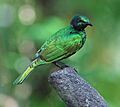Emerald starling facts for kids
Quick facts for kids Emerald starling |
|
|---|---|
 |
|
| Conservation status | |
| Scientific classification | |
| Genus: |
Lamprotornis
|
| Species: |
iris
|
| Synonyms | |
|
Coccycolius iris |
|
The emerald starling (Lamprotornis iris), also known as the iris glossy starling, is a small, super shiny bird! It has a bright, metallic green head, back, wings, and tail. Its cheeks and belly are a beautiful metallic purple. Both male and female emerald starlings look very similar.
Scientists often group this bird with many other shiny starlings in a group called Lamprotornis. However, some scientists think it's so unique that it should have its very own special group called Coccycolius.
Meet the Emerald Starling
The emerald starling is one of the smallest types of starlings. You can find these colorful birds in West Africa. They live in lowlands and savanna areas, which are like grassy plains with scattered trees. You can spot them in countries like Côte d'Ivoire, Guinea, and Sierra Leone.
What Does It Eat?
The emerald starling enjoys a varied diet! It loves to munch on figs, berries from the Haronga tree, and other types of fruit. They also eat seeds. For protein, they hunt for ants and other small insects.
Family Life
When it's time to build a home, the emerald starling chooses a cozy tree cavity. They build a cup-shaped nest inside. Both the male and female birds work together to build the nest, often using leaves.
After the chicks hatch, both parents help bring food to their hungry babies. Female starlings have a special spot on their stomach called a brood patch. This area has no feathers and helps them keep their eggs warm by transferring their body heat directly to them.
Is It Safe?
For a while, scientists didn't have enough information to know if the emerald starling was safe or if its numbers were shrinking. This was called "data deficient." But after more studies, they found out that these birds are actually quite widespread and common in many places.
Because of this, in 2015, their conservation status was changed to "least concern." This means they are not currently at high risk of disappearing. However, emerald starlings are sometimes caught for the pet trade. Also, mining activities in some areas can threaten them locally. Even with these challenges, it's unlikely to cause a major drop in their overall population.
Gallery





